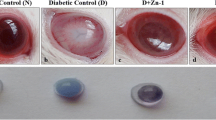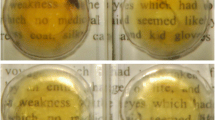Summary
Two groups of young rats were placed on diets of 35% galactose and 50% xylose. Groups of older rats were placed on diets of 35 or 50% galactose. Some of the animals were allowed to develop mature cataracts and others were sacrificed for the determination of lens components. Rats on xylose as well as galactose diets developed mature cataracts. The time required for cataract formation varied inversely with lens swelling. Lens swelling, however, did not parallel the concentration levels of the sugar alcohols. It is suggested that an unknown metabolite also contributes to the swelling of the lens in galactose and xylose fed rats.
Résumé
Deux groupes de jeunes rats recevaient un régime contenant 35% de galactose et 50% de xylose, tandis qu'un groupe de rats plus agés recevait 35 ou 50% de galactose. Dans l'un de ces groupes d'animaux le développement des cataractes jusqu'à la maturité était observé, dans un autre groupe les animaux étaient tués successivement pendant la maturation pour déterminer les contenus des cristallins. Les rats à régime de xylose et les rats à régime de galactose développaient des cataractes mûres. Le temps nécessaire pour la maturation de la cataracte était inversement proportionnel à la tuméfaction des cristallins. Mais la tuméfaction n'allait pas parallèle à la concentration des sucres. Il est possible qu'un métabolite pas encore connu contribue à la tuméfaction du cristallin quand les rats sont sous un régime de galactose et de xylose.
Zusammenfassung
2 Gruppen junger Ratten wurden auf eine Diät mit 35% Galactose und 50% Xylose gesetzt. Eine Gruppe älterer Ratten wurde auf eine Diät mit 35 oder 50% Galactose gesetzt. Bei einigen der Tiere wurde gewartet, bis sie eine reife Katarakt entwickelt hatten, andere wurden für die Bestimmung der Linsenzusammensetzung getötet. Ratten, welche sowohl Xylose als auch Galactose erhielten, entwickelten reife Katarakte. Die Zeit, die zur Ausbildung der Katarakte verging, variierte ungekehrt proportional mit der Quellung der Linse. Die Linsenquellung ging aber nicht dem Konzentrationsniveau der Zucker-Alkohole parallel. Es wird vermutet, dass ein unbekanntes Abbauprodukt zur Linsenquellung bei Ratten beiträgt, die mit Galactose und Xylose gefüttert werden.
Similar content being viewed by others
References
Bellows, J. G. Biochemistry of the Lens. IX. Influence of Vitamin C and Sulfhydryls on the Production of Galactose Cataract. Arch. Ophthal. 16, 762 (1936).
— Cataracts and Anomalies of the Lens. St. Louis, C.V. Mosley Co., p. 168 (1944).
Faulkner, P. Enzymic Reductions of Sugar Phosphates in Insect Blood. Biochem. J. 64, 436 (1956).
Kinoshita, J. H. & L. O.Merola. Hydration of the Lens during the Development of Galactose Cataract. Invest. Ophthal. 3, 577 (1964).
— & E.Dikmak. Osmotic Changes in Experimental Galactose Cataracts. Exp. Eye Res. 1, 405 (1962).
— & S.Hayman. Osmotic Effects on the Amino Acid Concentrating Mechanism in the Rabbit Lens. J. biol. Chem. 240, 310 (1965).
Nordmann, J. Etudes physico-chimiques sur le cristallin normal et pathologique. Arch. Ophthal. 52, 78; 170 (1935).
Patterson, J. W. Development of Diabetic Cataract. Amer. J. Ophthal. 35, 68 (1952).
— & K. W.Bunting. Lens Cell Membrane Permeability and Cataract Formation. Proc. Soc. exp. Biol. Med. 115, 1156 (1964a).
— Factors Limiting Glycolysis in the Lens. Invest. Ophthal. 2, 612 (1964b).
— Changes Associated with the Appearance of Mature Sugar Cataracts. Invest. Ophthal. 4, 167 (1965).
— & M. E.Patterson. Point of Irreversibility of Galactose Cataracts in Rats. Proc. Soc. exp. Biol. Med. 118, 324 (1965).
Salit, P. W., K. C.Swan & W. D.Paul. Changes in Mineral Composition of Rat Lenses with Galactose Cataract. Amer. J. Physiol. 25, 1482 (1942).
Strehler, B. L. & J. R.Trotter. Firefly Luminescence in the Study of Energy Transfer Mechanisms. Arch. Biochem. 40, 28 (1952).
West, C. D. & S.Rapoport. Modification of Colorimetric Method for Determination of Mannitol and Sorbitol in Plasma and Urine. Proc. soc. exp. Biol. Med. 70, 141 (1949).
Author information
Authors and Affiliations
Additional information
This research was supported in part by Research Grant AM 08344 from the National Institute of Arthritis and Metabolic Diseases, United States Public Health Services, Bethesda, Maryland.
School of Medicine, University of Connecticut.
Rights and permissions
About this article
Cite this article
Patterson, J.W., Bunting, K.W. Sugar cataracts, polyol levels and lens swelling. Doc Ophthalmol 20, 64–72 (1966). https://doi.org/10.1007/BF00165406
Issue Date:
DOI: https://doi.org/10.1007/BF00165406




